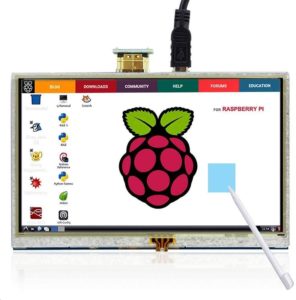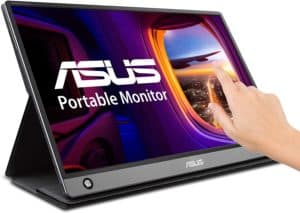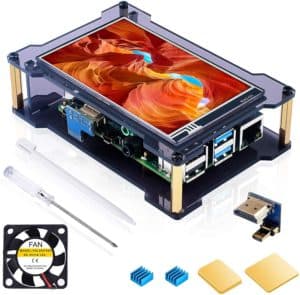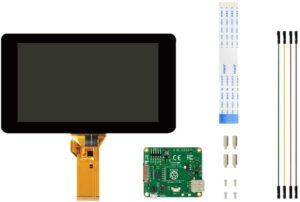Best Raspberry Pi Screen in 2023
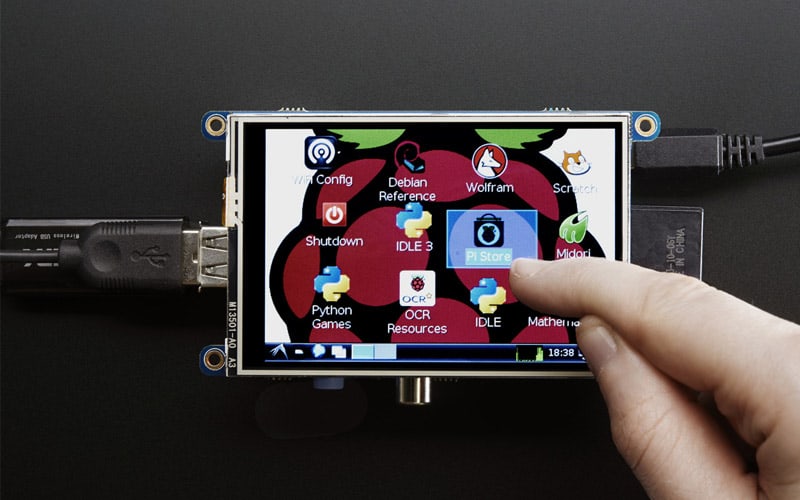
Table of Contents
As we approach the tenth anniversary of the Raspberry Pi coming to market and altering the landscape of DIY computing forever, there’s arguably never been a better time to jump in. With the Pi now in its fourth generation accompanied by a dizzying spread of accessories, add-ons, and peripherals designed specifically for the Raspberry Pi, it’s never been easier to tap into the full potential of the mini-computer that’s taken the world by storm.
From media servers to retro gaming through weather monitoring and robotics, there’s no end to the inventive ways tinkerers have tamed the Raspberry Pi’s power and compact form factor. If you fancy trying your hand at your own project and have picked up a Raspberry Pi of your own, you’ll more than likely hope to pair it with a good quality screen to bring its mini-computing might to life. To that end, we’ve compiled a list of the top screens for the Raspberry Pi to help you find one to suit your needs and project.
Other pieces you will require to make the perfect Raspberry Pi:
Products at a Glance
How We Picked
When shopping for a Raspberry Pi screen, there are multiple factors to consider, including resolution, screen size, panel type, the quality and accuracy of the colors, brightness, contrast, connectivity (and additional ports), power supply for wired options, battery life for wireless picks, weight, and other features like speakers, a stand, or even stylus. It’s also vitally important to consider how they pair and interfaace with the Raspberry Pi, whether that’s a back mounting bracket, standalone, or a all-in-one case-style screen design that houses the Pi.
While specifications are one thing, nothing beats hands-on time with a screen to gauge its quality; we, therefore, put each of our picks through their paces to ensure their match well with the Raspberry Pi.
Doing this allowed us to slim down our picks to five top recommendations. We’ve tried to cover various budgets and potential use cases to cater to as many users and projects as possible. You’ll find a brief introduction to each below alongside what impressed us and what didn’t. Finally, we’ve penned a handy ‘Things to Consider’ section at the end to help you navigate some of the jargon associated with Raspberry Pi screens.
Product Reviews
- 800 x 480 resolution
- 5-inch TFT LCD display
- 60 Hz refresh rate
- Resistive touch screen
- Low power consumption
- RPi back mounting
- Doesn’t have the most aesthetic finish
The Elecrow 5 Inch Raspberry Pi Touchscreen Display isn’t the most impressive or expensive Raspberry Pi touch screen out there, but that’s why we like it so much: it’s affordable yet has an excellent quality display equipped with everything required for a large variety of projects.
As for the specifications, the Elecrow 5 Inch Raspberry Pi Touchscreen Display features a 5-inch TFT LCD resistive touch screen panel (touch pen included) capable of a maximum resolution of 800 x 480 and with a smooth 60 Hz refresh rate.
It interfaces with the Raspberry Pi via HDMI with a nifty little micro-adapter that plugs into both the port on the Pi and screen simultaneously without miles of cabling. The two standoff mounting mechanism allows the Pi to sit behind the screen with minimal setup. The screen is compatible with the Raspberry Pi Model B+, Raspberry Pi 2 Model B, and Raspberry Pi 3 Model B and Model B+.
The 5V low power requirements is another highlight, with the Elecrow 5 Inch Raspberry Pi Touchscreen Display sourcing enough power to run from either the GPIO pins on the Pi or micro-USB port with any standard Pi power supply.
The Elecrow 5 Inch Raspberry Pi Touchscreen Display is very much a screen for Raspberry Pi tinkerers and has the aesthetics to match, which are rough around the edges, with an exposed finish that may not suit those that prefer a more stylish look for their screen. We see this as a perfect option for those who want to try their hand designing and 3D printing a case for the screen and Pi.
- 15.5-inch IPS touchscreen display
- 1920 x 1080 resolution
- Lightweight and portable
- 7800 mAh battery
- Built-in speakers
- Ships with Smart Cover and Smart Pen
- Expensive
- No Raspberry Pi mounting
The ASUS ZenScreen sets itself apart from the other screens in our list in that it’s designed for portability, a boon for mobile Pi projects and users that want a media station they can easily carry around.
The ASUS ZenScreen features a 15.5-inch IPS display, 1920 x 1080 resolution, in-built speakers, and a robust 7800 mAh battery. The display is of the touch screen variety allowing for intuitive 10-point fingertip control and gestures alongside excellent accuracy and responsiveness.
The screen is also lightweight at 2 lbs and measures no more than 0.3-inches in width, making it an ultra-portable option despite the large screen size. We also like that it ships with a foldable Smart Case that also doubles as a multi-position stand and holder for the included Smart Pen.
As for interfacing with the Raspberry Pi, the ASUS ZenScreen uses either HDMI or USB Type-A/Type-C. As the ASUS ZenScreen isn’t designed specifically for the Raspberry Pi, there’s no integrated mounting mechanism, so expect to have your Pi sitting alongside the screen when it’s in use.
With an asking price of just shy of $350, the ASUS ZenScreen is by no means cheap. The cost raises whether it would be more advisable to simply buy a tablet, budget laptop, or a $200 PC monitor. The portability baked into the screen, excellent image quality, touch screen controls, and Raspberry Pi compatibility are major highlights. However, they don’t necessarily warrant such a high price tag.
- 800 x 480 resolution
- 4-inch IPS touch screen and stylus
- 60 Hz refresh rate
- Case design with fan and heat sinks
- Integrated audio, HDMI, and USB ports
- Only compatible with Raspberry Pi 4
- More involved assembly
- Limited GPIO access
Rather than simply providing a screen, the Miuzei Raspberry Pi 4 Touchscreen with Case & Fan proposes an entire home (read case) for the Raspberry Pi with a compact all-in-one option perfect for those on the hunt for a small form factor solution.
First; the screen. It boasts a 4-inch IPS touch screen LCD capable of pushing a maximum resolution of 800 x 480 and a refresh rate of 60 Hz. We recorded good color accuracy and a sharp image during our time with the Miuzei Raspberry Pi 4 Touchscreen with Case & Fan.
The screen connects to the Raspberry Pi via an included HDMI mini-adapter that sits inconspicuously within the dimensions of the case. The screen features four integrated ports (micro USB, audio, HDMI, and a button to adjust brightness and toggle the back-light on and off). Additionally, a 30 mm fan helps keep both the Pi and screen cool under heavy loads.
As for the case, it sandwiches the Raspberry Pi between two acrylic layers held together by four large standoffs. The screen sits flush with the top layer, while the bottom layer offers some protection for the underside of the Raspberry Pi. This all means the screen can be powered via the Pi’s GPIO or via a power supply hooked up to the USB port on the back plate.
Assembly is quite involved compared to other plug-and-play screens in our guide, and the case does limit access to the GPIO ports on the Pi, which may trouble those using HATs for their projects. Miuzei does, however, supply a four-piece heat sink kit and all the screws/standoffs you’ll need for assembly.
It’s worth noting that by its design, the Miuzei Raspberry Pi 4 Touchscreen with Case & Fan is only compatible with the Raspberry Pi 4 and none of the older generation models.
- 1920 x 1080 resolution
- 13.3-inch IPS LCD
- 60 Hz refresh rate
- Thin and lightweight
- In-built speakers
- Folding stand
- Integrated ports and controls
- Pricey
Those looking to hook their Pi up to a massive display should look no further than the SunFounder Raspberry Pi Display with a screen size usually reserved for laptops: a generously sized 13.3-inch IPS LCD capable of a crisp 1920 x 1080 resolution and fluid 60 Hz refresh rate.
The image quality is top tier with excellent colors, high brightness levels, and plenty of contrast for a sharp, crisp visual experience. The SunFounder Raspberry Pi Display is also very thin, a mere 15 mm in width, and even comes packed with a handy folding metal stand and VESA mount.
The screen supports multiple video inputs via two HDMI ports with automatic source recognition and switching, ideal for projects that juggle a Pi with another device that requires a screen. The SunFounder Raspberry Pi Display also turns heads for a range of integrated ports (audio, HDMI x2, USB Type-C) and media controls incorporated into the side of the device (volume, menu, source switcher, and power). There’s also a pair of in-built speakers. The audio quality is nothing to write home about, but a nice addition nevertheless.
The screen sources power from an included power supply. Connect it to the Pi’s USB Type-C port, and it can power the mini-computer too. The SunFounder Raspberry Pi Display offers compatibility with all Raspberry Pi generations via a fairly rudimentary mounting bracket on the back, which works well enough.
While there’s plenty to like about the SunFounder Raspberry Pi Display, the $150 asking price may be a bit too steep for those eager to get their hands on a more budget-friendly option.
- Low price
- 7-inch touchscreen
- 10-finger touch commands
- Mounting bracket and adapter board
- Genuine RPi part
- Underwhelming resolution
- Brightness levels
An official product from the folks at Raspberry Pi, the Raspberry Pi 7″ Touch Screen Display taps into the same DIY ethos as the mini-computer itself with an attractive price tag of around $65 to match.
The screen features a full-color 7-inch touchscreen display capable of registering 10-finger touch commands and gestures. It has a resolution of 800 x 480 – relatively low for a 7-inch screen but suitable for most small form factor Pi applications.
It also boasts an adapter board mounted on the back that handles everything from signal conversion to touch inputs and power management. The adapter also doubles as a mounting bracket with four standoffs to attach the Raspberry Pi. It’s a relatively compact and clean setup that should suit tablet-style and embedded projects, although it doesn’t include a stand or case.
Put to the test; the Raspberry Pi 7″ Touch Screen Display delivers respectable color and top-notch touch responsiveness. However, the brightness levels do suffer in situations with ample light, such as the outdoors. For the price, these are minor issues as you do get a decent screen with the added benefit of Raspberry Pi’s official stamp of approval. Like the Elecrow 5 Inch Raspberry Pi Touchscreen Display, this is a DIYers screen, so don’t expect effortless out-of-the-box functionality like the more expensive options above.
Things to consider
Screen size
Screen size refers to the physical dimensions of the screen, and more specifically, the viewable area. Screen size is measured diagonally from one corner of the screen to the other, generally listed in inches.
In the case of Raspberry Pi screens, sizes tend to be smaller compared to full-fat PC monitors and are more in line with those found on tablets, in the range of 4-inches to 10-inches in a lot of cases, although it’s entirely possible to use laptop-sized screens such as 13-inches or 15-inches with no issues. We’ve included a couple of those above for those among you that require a large viewing area for their Raspberry Pi project.
Ultimately, your project and budget dictate what screen size you’ll need.
resolution
Resolution refers to the specific count of horizontal and vertical pixels that a given screen can display. Resolution correlates directly with detail, and as such, a higher resolution will appear sharper and more refined if used to display appropriate resolution content than screens with a lower resolution. You may have come across terms like 720p or 1080p, which allude to the vertical pixel count, i.e., 1080p is a resolution of 1920 x 1080, while 720p is a resolution of 1280 × 720.
As a general rule, we suggest going for the highest resolution screen your budget allows, although some screens, notably smaller ones, won’t benefit all that much from a higher resolution. As such, we recommend buying according to how and where you aim to use the screen/Raspberry Pi combo. Our recommendations include 1080p options and smaller 480p alternatives for those who want to keep costs low or need a small form factor screen.
Raspberry Pi Mounting and Compatibility
Another point to consider is, first, whether a screen is compatible with your Raspberry Pi model, and secondly, how you’ll mount the Pi on the screen, if at all. A standard solution is to have the Raspberry Pi mounted on the back of the screen. Otherwise, screens that double as cases for the Pi are popular, although the small form factor limits the screen size. Finally, we have large screens that feature no mounting or housing for the Pi. Here, it’s typical to see the Raspberry Pi housed in its own case and connected to the screen via a USB cable.
Can I use any screen for Raspberry Pi?
Raspberry Pis come with an HDMI output port which is compatible with most modern TVs and monitors. Raspberry Pi 4s have two HDMI outputs allowing you to connect to two monitors at the same time.
If you want to connect to more monitors then a HDMI splitter is required, luckily we have a guide to the best HDMI splitters you can buy.
Can Raspberry Pi run 4K monitor?
Yes, the Raspberry Pi 4 allows an output of 4k resolutions, this is due to it allowing 4 times the amount of RAM when compared to the Raspberry Pi 3.
Our Verdict
If you want to save yourself the trouble of trawling through dozens of screen listings and want us to point you in the direction of one of the best Raspberry Pi screens out there, the Elecrow 5 Inch Raspberry Pi Touchscreen Display is a top pick in our book.
With a massive 15.5-inch touchscreen display, a 1080p resolution, and a long-lasting in-built battery, the ASUS ZenScreen takes the crown as one of the best portable Raspberry Pi screens on the market. The hefty asking price may put off some, though.
The Miuzei Raspberry Pi 4 Touchscreen with Case & Fan is an excellent all-in-one solution: case, cooling solution, and screen all bundled into one.
Those looking for a screen with a size typically found on a laptop should find plenty to be excited about with the SunFounder Raspberry Pi Display and its 1080p resolution, 60 Hz refresh rate, and integrated ports/controls.
Lastly, the Raspberry Pi 7″ Touch Screen Display is not only an official RPi product but is among the most cost-effective ways to spruce up your Pi project with a decent quality screen.
With that, we’ll wrap up our guide to the best Raspberry Pi screens. As always, head to the comments section below should you have any pressing questions, suggestions, or concerns.

